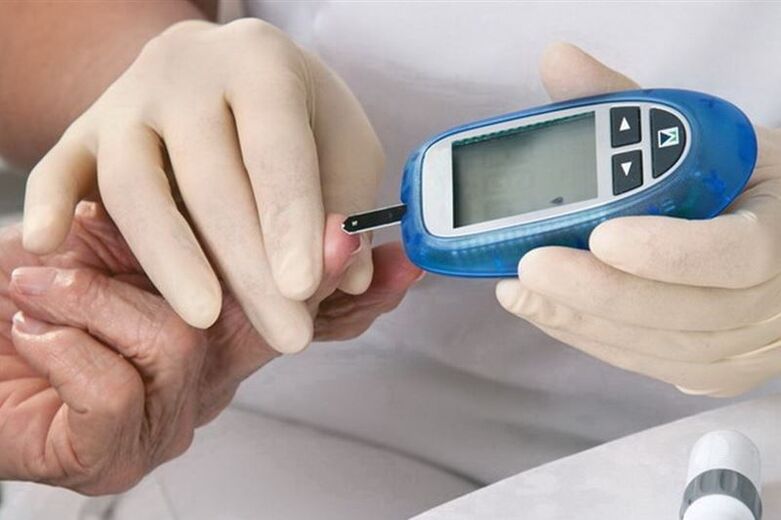Diabetes mellitus is considered to be the most common endocrine disease. Improper nutrition, lack of exercise and hereditary predisposition - these factors increase the risk of their occurrence. Today, about 347 million people worldwide suffer from pathology. In the last two decades, the number of cases has increased tenfold. If it is detected at an early stage, serious complications can be avoided. Therefore, it is important to know how diabetes manifests itself.
Causes of diabetes and its types
Diabetes mellitus is a disease characterized by a disorder in the body's metabolism. It is linked to insufficient production of the hormone insulin by the pancreas. Its deficiency leads to the accumulation of sugar in the body.

Normally it should be processed into glucose due to the action of insulin. This process is accompanied by malaise and other symptoms. Sugar itself is excreted in large quantities in the urine, causing gradual dehydration and a constantly insistent feeling of thirst.
The exact causes of the disease have not yet been investigated. However, doctors identify a group of factors that increase the risk of their occurrence.
- hereditary predisposition.
- overweight.
- Pathologies of the pancreas (cancer, pancreatitis).
- Exposure to viruses (flu, rubella, and smallpox are particularly dangerous).
- Frequent stress.
- Advanced age.
The classic classification of the disease provides for the assignment of its two forms: type 1 and type 2 diabetes. The first option is considered the most dangerous and is lifelong. In order to maintain the normal state of the body, insulin must be constantly injected intramuscularly. In the second type, the body produces this hormone, but not in the required amount.
There are also the following types of diabetes: gestational, insipidus, steroid, latent, autoimmune, bronze diabetes. Each of the forms is characterized by its own clinical picture and course characteristics.
How is type 1 and type 2 diabetes manifested?
Diabetes is an insidious disease. A person may be unaware of health problems for many years until they fall into a hyperglycemic coma. Therefore, it is important to know the main manifestations of pathology, taking into account their diversity.
Table 1. Manifestations of type 1 and 2 diabetes mellitus
| type of diabetes | clinical picture |
|---|---|
| type 1 diabetes |
|
| Type 2 diabetes |
|
The clinical picture may vary slightly depending on the patient's age and gender.
Signs of the onset of diabetes in children
Identifying pathologies in children is easy. It is important to do this in a timely manner to avoid developing a diabetic coma. It occurs spontaneously and can be fatal if the child is not treated medically.
The early signs of diabetes in children are:
- Frequent and profuse urination. If the baby still goes to the pot, it is easy to identify this symptom. Problems with urination mainly occur at night. Parents often have to change diapers and bedding.
- The child is constantly thirsty. If diabetes is suspected, compotes and juices should be replaced with plain water. If in this case the thirst does not decrease, you should consult a doctor.
- Inconsistency in weight and amount of food eaten. The child eats a lot, but it doesn't get better. Another option is also possible: the child eats little, but his body weight is growing rapidly.
In addition to these symptoms, diabetes can present with itching, constant tiredness even after rest, and dry mouth.
The onset of diabetes in men
The clinical picture of the disease in men is no different from the general one. However, all signs can be added inflammation of the foreskin, the entire urethra. This happens through frequent urination. The concentration of sugar in the urine is quite high, which leads to irritation of the tissues of the organ and the foreskin itself.
Diabetes diseases in women
In the fair sex, the onset of the disease manifests itself as severe thirst, drowsiness and itching. However, the pathological process often affects the reproductive system, which is accompanied by the following symptoms:
- Violation of the menstrual cycle. Bloody discharge can be completely absent for several months, and then appear in the form of clots.
- The appearance of ulcers on the mammary glands. They are often confused with allergies, but ongoing treatment does not bring positive results.
- Weight loss or gain for no apparent reason.
The latter symptom is more common in women than others. With a high-calorie diet, patients can lose up to 10 kg in weight. On the other hand, while adhering to a strict diet, some, on the contrary, gain weight. Usually such a violation is perceived as a malfunction of the endocrine system. Only after passing the tests are serious health problems revealed.
Symptoms of gestational diabetes
Gestational diabetes only develops in pregnant women. It has no specific external characteristics. It is usually detected during routine check-ups that are regularly prescribed to women in position. The basis for the diagnosis are the results of blood and urine tests.
External manifestations of the disease practically do not differ from those of type 1 and type 2 diabetes. We are talking about nausea, weakness, constant thirst. These symptoms do not appear individually and do not indicate toxicosis. They mainly develop in the second and third trimesters.
The gestational form of the disease does not pose a direct threat to the woman and the fetus in the womb. However, it can negatively affect their overall well-being and the course of their pregnancy. High glucose levels lead to the birth of a heavy child (from 4 kg).
This is often seen as a prerequisite for obesity and the onset of diabetes directly in the child. In some cases there is a slight delay in development. Sometimes diagnosed with jaundice, hypoglycemia.
What to do if you have diabetes symptoms?
If you suspect diabetes, you should not self-medicate or ignore the early symptoms. This disease is within the competence of an endocrinologist. However, a therapist can make a diagnosis.
In any case, to determine the presence of a pathological process, you need to seek medical help. The specialist first listens to the patient's complaints, studies their medical history and performs a physical examination. Only on the basis of these measures can a preliminary diagnosis be made. To confirm this, you need to undergo a full examination.
diagnosis of the disease
Any research into suspected diabetes is aimed at determining the level of glucose in the blood.
Most often, patients are offered to take a blood test for sugar. Before delivery, you can not eat anything for 8-12 hours. Alcohol is also forbidden. Better stop smoking. Normally, the glucose indicator should be 5. 5 mmol per liter. If this parameter is 7 units or more, then an additional check is assigned.
The patient is asked to undergo a glucose tolerance test. The analysis consists of several parts. First, the patient undergoes a standard fasting blood test. Then in a medical institution he drinks a glass of water with sugar (75 g of the substance per 200 ml of water). After 2 hours he takes another blood test.
In a healthy person, according to the first study, the rate is up to 5. 5 mmol per liter, and after the second - up to 7. 8 mmol per liter. If these parameters are slightly exceeded (by a few tenths), the doctor will conclude that the condition is prediabetic. Significantly higher values than these numbers already indicate diabetes.
Some are prescribed an analysis for glycated hemoglobin. With it you can track the state of glucose in the blood over the last 3 months. Typically, this number should be less than 5. 7%. Values in the range of 5. 7-6. 4% indicate a high risk of developing type 2 diabetes.

In this case, the patient should discuss with the doctor measures to prevent the disease. If the level of glycated hemoglobin is more than 6. 5%, diabetes is likely. However, confirmation by additional tests is required.
Possible complications
The disease itself does not pose a threat to human life, but it is subject to the doctor's recommendations. Its complications are dangerous. Among them, the following are the most common:
- neuropathy. The pathology is manifested by burning, severe pain and numbness in the lower extremities. It arises due to metabolic disorders in the central nervous system. Treatment involves taking drugs with thioctic acid. With timely seeking medical help, the patient manages to restore nerve tissue.
- diabetic coma. Your symptoms are increasing rapidly. Therefore, the patient is immediately hospitalized. At first, he can complain about darkening of the eyes and mental retardation. There are several variants of this condition, but ketoacidosis is the most common. It is characterized by the accumulation of toxins in the body, which quickly destroy nerve cells.
- Trophic Ulcers. This is a serious pathology that significantly affects the quality of human life. If therapy is not started on time, trophic ulcers can begin to fester.
Diabetes can also lead to other health problems. They manifest themselves in the form of functional disorders of various organ systems (liver, kidneys, organs of vision).
prevention of diabetes
First of all, it should be noted that the occurrence of type 1 diabetes is difficult to predict. The disease is predominantly hereditary. Various viruses increase the likelihood of their development.
Type 2 diabetes is much easier to prevent. Their occurrence directly depends on the quality of human life. Addiction, an inactive lifestyle, alcohol abuse - all these factors can provoke the disease. Therefore, doctors give the following recommendations for prevention:
- Control body weight (try to eat right and balanced).
- Monitor your blood pressure and see a doctor for treatment if necessary.
- Do challenging sports.
- Timely treat diseases, especially those related to the endocrine system.
By following these simple guidelines, you can protect yourself from diabetes. A healthy lifestyle and proper nutrition are key to the full functioning of the body.
Diabetes mellitus is a serious disease that usually requires lifelong insulin intake. If you neglect treatment, the pathological process can become more complicated and lead to rather unpleasant consequences.
The latter include diabetic coma, trophic ulceration of the lower extremities, and neuropathy. In order to protect yourself from such troubles, it is important to know the first symptoms of the disease, and when they appear, immediately consult a doctor. After passing the examination, which mainly consists of determining blood sugar levels, the specialist can select a therapy.



























